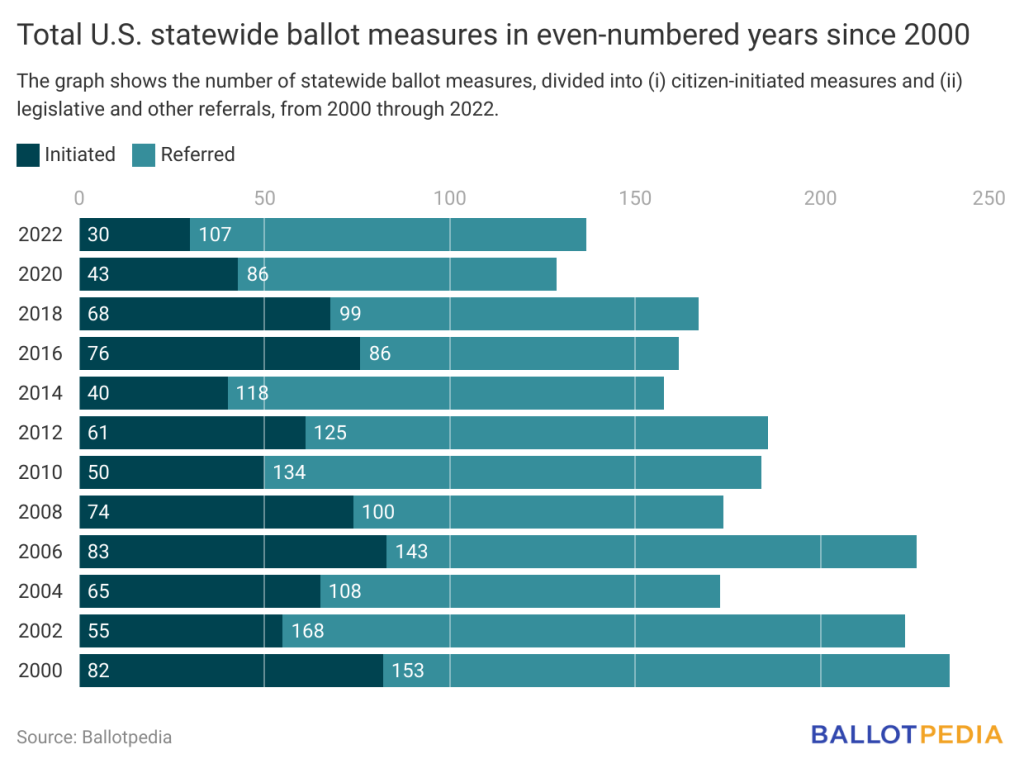Voters in 36 states will decide on 129 ballot measures at the general election on November 8. As five ballot measures were decided at elections earlier this year, and three more will be decided in December, the annual total of statewide ballot measures for 2022 is 137.
Across the U.S., ballot measures will address issues like abortion, marijuana, and election law in November. Topics like sports betting, psychedelic fungi and plants, flavored tobacco, alcohol, firearms, and income taxes are featured on ballots in some states.
Number of citizen-initiated measures below average
This year’s annual total—137—is more than the number of statewide ballot measures in 2020, which was 129. However, the annual total is below the previous decade’s (2010-2020) average of 164.
The number of citizen-initiated ballot measures and legislative referrals has decreased since 2010. The number of citizen-initiated measures in 2022 is 30, which is the lowest number during the prior decade. In 2020, there were 43 citizen-initiated measures.

There could be several reasons for the lower number of initiatives in 2022. For 2022, 851 initiatives were proposed, and 3.5% made the ballot. In 2016, for instance, 1,069 initiatives were proposed, and 7.1% made the ballot. Overall, there is a correlation between the number of initiatives proposed and the number certified for the ballot, and there is also a decade-long trend toward fewer proposed initiatives making the ballot. There are also fewer initiatives, on average, during mid-term years compared to presidential years. From 2010 to 2022, presidential years featured an average of 60 citizen-initiated measures, whereas mid-term years featured an average of 47 citizen-initiated measures. Campaigns have also cited the effects of COVID-19 and labor shortages on signature drive costs in 2022.
An additional factor for ballot initiative campaigns is recent signature increases. Of the 26 states that allow for some form of initiative or referendum, 22 states base their signature requirements on turnout at specific elections, which either occurred in 2018 or 2020. According to the U.S. Elections Project, the midterm turnout in 2018 was 50%, the highest since 1912, and 13.3 percentage points above 2014. The presidential election turnout in 2020 was 66.8%, the highest since 1900, and 6.7 percentage points above 2016. In California, which saw the largest signature increase, the requirement increased by 70.3%.
Trends include abortion, marijuana, and election policies
Abortion has been a topic for statewide ballot measures since the 1970s. Since 2000, there have been just two general election cycles, 2002 and 2016, without abortion-related state ballot measures. In November, there are five ballot measures addressing abortion—the most on record for a single year. Earlier, in August, one measure was defeated in Kansas. Before 2022, the highest number of abortion-related measures on statewide ballots was four in 1986. In California, Michigan, and Vermont, voters will decide on constitutional rights to abortion. In Kentucky, like Kansas, voters will decide on a constitutional amendment to declare that the state constitution cannot be interpreted as creating a right to abortion. Voters in Montana will decide on a measure requiring medical care to be provided to infants born alive after an attempted abortion or other procedure.
Heading into November, marijuana is legal in 19 states and D.C. Of those 19 states, 13 and D.C. had legalized marijuana through the ballot measure process. In 2022, five more states will decide on marijuana legalization ballot measures. In the central U.S., voters in Arkansas, Missouri, North Dakota, and South Dakota will consider citizen-initiated measures to legalize marijuana. In Maryland, the state legislature voted to put the issue before voters.
Voters in 10 states will decide on ballot measures to change election policies or laws in November. South Dakota decided on a measure in June, and Louisiana will decide on one in December. Voters will decide on a top-five ranked-choice voting system in Nevada, where approval of an initiated constitutional amendment is required twice in 2022 and 2024. Voters in three states will decide on legislative proposals to change the processes for citizen-initiated ballot measures this year. Other issues on the ballot include early voting, voter identification, citizenship requirements, and campaign finance reporting.
You can learn more about this year’s statewide ballot measures at Ballotpedia.org.
Learn More






